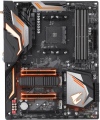Add to comparison |  |  |
|---|---|---|
| Gigabyte X470 AORUS GAMING 5 WIFI | Gigabyte X470 AORUS ULTRA GAMING | |
| Outdated Product | Outdated Product | |
| User reviews | ||
| TOP sellers | ||
Optical sound card output. Improved ALC1220 audio codec. Features of the power system limit overclocking capabilities. | ||
| Features | gaming for overclocking | gaming for overclocking |
| Socket | AMD AM4 | AMD AM4 |
| Form factor | ATX | ATX |
| Power phases | 11 | 11 |
| VRM heatsink | ||
| LED lighting | ||
| Size (HxW) | 305x244 mm | 305x244 mm |
Chipset | ||
| Chipset | AMD X470 | AMD X470 |
| BIOS | Ami | Ami |
| DualBIOS | ||
| UEFI BIOS | ||
RAM | ||
| DDR4 | 4 slot(s) | 4 slot(s) |
| Memory module | DIMM | DIMM |
| Operation mode | 2 channel | 2 channel |
| Max. clock frequency | 3200 MHz | 3600 MHz |
| Max. memory | 64 GB | 64 GB |
| XMP | ||
Drive interface | ||
| SATA 3 (6Gbps) | 6 | 6 |
| M.2 connector | 2 | 2 |
| M.2 | 1xSATA/PCI-E 4x, 1xPCI-E 4x | 1xSATA/PCI-E 4x, 1xPCI-E 4x |
| M.2 SSD cooling | ||
| Integrated RAID controller | ||
Expansion slots | ||
| 1x PCI-E slots | 2 | 2 |
| PCI-E 16x slots | 3 | 3 |
| PCI Modes | 16x/0x/4x, 8x/8x/4x | 16x/0x/4x, 8x/8x/4x |
| PCI Express | 3.0 | 3.0 |
| CrossFire (AMD) | ||
| SLI (NVIDIA) | ||
| Steel PCI-E connectors | ||
Internal connections | ||
| USB 2.0 | 2 | 2 |
| USB 3.2 gen1 | 2 | 2 |
| USB C 3.2 gen2 | 1 | 1 |
Video outputs | ||
| HDMI output | ||
Integrated audio | ||
| Audiochip | Realtek ALC1220 | Realtek ALC1220 |
| Sound (channels) | 7.1 | 7.1 |
| Optical S/P-DIF | ||
Network interfaces | ||
| Wi-Fi | Wi-Fi 5 (802.11aс) | |
| LAN (RJ-45) | 1 Gbps | 1 Gbps |
| LAN ports | 1 | 1 |
| LAN controller | Intel GbE | Intel GbE |
External connections | ||
| USB 2.0 | 4 | 4 |
| USB 3.2 gen1 | 4 | 4 |
| USB 3.2 gen2 | 1 | 1 |
| USB C 3.2 gen2 | 1 | 1 |
Power connectors | ||
| Main power socket | 24 pin | 24 pin |
| CPU power | 8 pin | 8 pin |
| Fan power connectors | 8 | 8 |
| Added to E-Catalog | april 2018 | april 2018 |